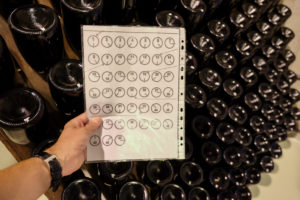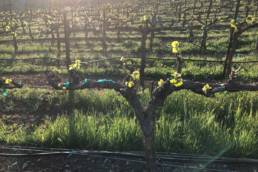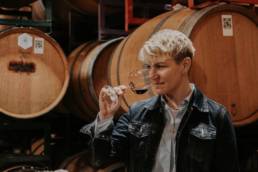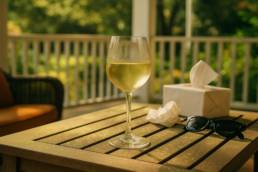FMN – January 2021 – Wine With Stars
We survived the challenging last twelve months, to say the least, and look to the promise that the impending New Year will bring better times. During these celebrations, as others of the same ilk, sparkling wine seems to be a favorite pop-and-pour for many gatherings. Although I welcome the opportunity to consume the “wine with stars”, I remain put off by the relegation of this infamous beverage to celebratory events and special occasions. After the past year, many have come to realize that life itself is a special occasion; one we should continuously rejoice in by opening and consuming a gratuitous amount of sparkling wine.
As with any beverage, the final product depends on the base material and methods of production. In our case, the choice of grape variety, mandated by appellation law or by winemaker’s whim, begins our beverage journey. Although this is an oversimplification not taking into account viticulture decisions or ripeness levels at harvest, it remains a respectable starting point as a proverbial “fifty thousand foot view” to understand sparkling wine processes.
The molecule carbon dioxide gives the sparkle to sparkling wine; as this gas is dissolved into the liquid wine and effervesces out of solution during opening and pouring. The distinctive element of production is the means to which carbon dioxide gets into the wine. This, in turn, affects the nature of the fizz, the size of the bubble and the textural feel on the palate. I know all this sounds technical and a bit off the wall but, as you will determine for yourself, the proof is truly in the tasting.
There are multiple ways to make a beverage containing carbon dioxide bubbles. The easiest (and cheapest) method remains injecting it into the liquid under pressure; the way a majority of sodas are produced. There are sparkling wines made by this carbonation method but…, well that’s all I have to say about that. If you have a soda stream or similar product, experiment at home by adding some carbonation to your favorite wine.
The obscure “Continuous Method” was invented in Russia and the name coined due to the continuous addition of liqueur de triage (yeast and sugar) to the base wine. The wine travels through a series of tanks as the second ferment occurs, resulting in a finished wine contained in the final tank. Wood chips can even be added to impart more complexity. Other than Russian, German and Portuguese mass produced sparkling wines, we see very little of this process throughout the world. I felt it would be remiss not to at least make mention and I’m certain my sparkling wine geeks would call me out on it.
The historic Méthod Ancestrale may be the oldest means of sparkling wine production and credited to the monks of Saint-Hilaire in Limoux. This method is a continuation or restart of the first fermentation rather than a true second ferment. The wine is chilled to halt fermentation and bottled. Since the yeast and residual sugars remain, fermentation restarts in the now-sealed bottle only to trap the resulting carbon dioxide. As the pressure inside the bottle increases, the carbon dioxide gas becomes dissolved into the liquid wine resulting in “sparkle”.
With growing popularity of the natural wine movement, the production of pétillant naturel (aka pét-nat) has adopted this process with their sparkling wines. Although being experimented with all over the world, they have an established home in Jura, Loire Valley and the historic Limoux. The fact that these wines tend to be fruit forward, slightly off-dry, a little funky and boast a lower alcohol level have endeared them to the market and developed a cult like following.
The Charmat process (aka tank method) was patented by the French wine maker Eugene Charmat in 1907 and has become one of the most popular means of sparkling wine production. The base wine is placed in a stainless steel tank and the liqueur de triage added to the closed system. At a desired point in the process the wine is chilled to arrest the second fermentation and the yeast filtered off. The resulting sparkling gets bottled under pressure. The lack of extended yeast contact ensures these wines are fruit forward and very fresh on the palate. Many wines are made with this process including German Sekt, Lambrusco, much UK and Eastern Europe sparkling and our beloved Prosecco.
Finally we have the renowned Traditional Method, formerly known as method champenoise. These wines are definitely all about the process. Base wines from different vineyards and even different years are blended and placed into the very same bottle you buy on the store shelves. The yeast and sugar are added (liqueur de triage) and a crown cap placed on the bottle. Second fermentation takes place trapping the bubbles inside the wine.
 At this time the bottles are traditionally riddled over a number of years; meaning they are turned a quarter turn each riddle and over time tilted until the bottles finish upside down, termed sur pointe. This process slowly moves the settled expired yeast to the opening of the bottle. The bottle neck then gets an iced brine bath freezing the yeast and the bottle disgorged; opening the crown cap and the yeast plug expelled under pressure.
At this time the bottles are traditionally riddled over a number of years; meaning they are turned a quarter turn each riddle and over time tilted until the bottles finish upside down, termed sur pointe. This process slowly moves the settled expired yeast to the opening of the bottle. The bottle neck then gets an iced brine bath freezing the yeast and the bottle disgorged; opening the crown cap and the yeast plug expelled under pressure.
During the removal of the yeast, some wine gets spilled so the bottle is “topped off” with some base wine, liqueur d’ expedition, perhaps some sugar and the cork pressed into the bottle. Due to extreme pressures, a muselet (wire cage) is added to ensure cork stability. The pressure inside these bottles is quite impressive (4 -6 atmospheres or 60 – 90 psi) so chilling these helps make it a bit safer and the pressurized cork a bit more ruly.
Although we are quite familiar with Champagne being made by this process, many other countries and regions have adopted this method. Notable mentions include Cap Classique in South Africa, Franciacorta in Lombardy, Italy, and Crémant (traditional method sparkling made in France but outside the borders of the Champagne appellation). Many famous Champagne houses have partnered with producers in the United States resulting in exceptionally good traditional method sparkling made domestically.
So looking ahead to the promise of a better 2021 many will make resolutions for the New Year. Following the herd, I plan to make some of my own but with a slight twist. I resolve to include more sparkling wine in my life with regards to humdrum weekday happenings, routine sporting events and even main course dinner pairings. With the past year, we have plenty of reasons to drink but we can at least do so in “celebratory fashion”.
Suggested Wines:
Poggio Costa Brut Prosecco DOC, Italy $12.99
This wine contains 100% Glera (aka Prosecco) and has classic aromas of orchard fruit (peach and pear). The palate is dry with flavors of orchard and tropical fruits and a lingering fruit skin finish. The mousse is slightly prickly but pleasant nonetheless. This would make a great Bellini mixer or a chill and spill for those upcoming dinner parties.
La Marca Luminore Conegliano – Valdobbiadene Prosecco Superiore DOCG $23.99
This classic Prosecco comes from the more strict DOCG area and has notable concentration and pronouncement of fruit. The nose has rich, ripe peach nectar, nectarine, tangerine and an interesting spearmint quality. The palate offers a certain smoothness from the bubbles, with a ripeness of fruit which gives it an off-dry perception. The palate mirrors the nose with rich orchard fruit and tropical elements. The finish lingers pleasantly with peach nectar and a floral peach blossom. Pair with salty meat charcuterie, pork tenderloin with peach chutney, or grilled fruit.
Taittinger Domaine Carneros Vintage 2016 Brut Napa, California $32.99
One first appreciates the nuances of brioche and fresh baked bread from yeast breakdown (autolysis). The aromatics continue with red fruit (cherry, cranberry) and blood orange’ a tribute to the Pinot Noir and Chardonnay within. The dry palate has mouth caressing fine mousse with flavors of tangerine, tart cherry, white plum and the crust on fresh baked bread. The acidity is evident but well balanced with a prolonged ever evolving finish. This has almost endless pairing opportunities: Oysters with mignonette, caviar with cream cheese on blini, or the start of a great evening.
Taittinger Brut La Francaise Champagne NV Reims, France $49.99
James Bond’s favorite Champagne according to the original Ian Fleming novels Taittinger uses a classic blend of 40% Chardonnay, 35% Pinot Noir and 25% Pinot Meunier for this non-vintage wine. The nose has a toasted note with slight red fruit, tropical citrus, and orchard fruit. The palate is bright, dry and lingers of baguette baked in a stone oven. Slightly rustic and slightly sexy, this wine has a balance of two worlds. This would pair with everything from lobster roll on a brioche bun, aged brie or fried mozzarella.
Los Monteros Cava Brut, NV Requena, Spain $9.99
This 100% Macabeo shows true to the variety with aromas of apple, apple blossom and a creamy yoghurt quality. The palate remains dry with evident tart acidity and flavors of cider apple meets green apple. The fine bubbles add texture to the mouthfeel and finish with a tart palate cleansing acidity. This is one of the great value Cava wines. Pair with creamy cheeses, ceviche or as an aperitif.
Raventós I Blanc De la Finca Conca del Riu Anoia, Penedès, Spain $65.98
This may be one of the best Cava wines I have ever had the pleasure of tasting. An interesting blend of 50% Xarel.lo (Shar-ale-low), 40% Macabeo & 10% Parellada, this wine truly pays homage to what this area can produce. The nose shows obvious prolonged lees contact with baked brioche, bruised apple, yellow plum, tangerine, and an earthy hint of “oyster mushroom”. The palate is dry with tart tropical citrus acidity and a viscous texture and palate caressing fine bubbled mousse. Flavors of tangerine, orchard fruit and baked pie crust give the illusion of a pastry with citrus marmalade. The prolonged finish has a slight earthy nuance. Pair with citrus enhanced poultry dishes, foul with mushroom sauce or Spanish seafood tapas (pinchos).
Lini 910 Labrusca dell’ Emilia Rosé Emilia-Romagna, Italy $14.99
One first notices the beautiful dark salmon rosé color of this 50% Lambrusco Salamino, 50% Lambrusco di Sorbara. The nose has elements of tart cherry, cranberry, and a marzipan and flor like nuance. The palate is dry with a tart acidity and flavors of cherry, strawberry and a slight rhubarb / strawberry pie note. The mousse is short-lived as is the finish. This remains a very fun and interesting sparkling wine that would pair with preserved meat type charcuterie, poultry with red berry sauces or savory pastry styled desserts.




